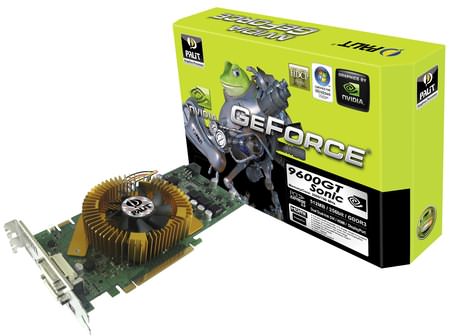TechRadar Verdict
It's been a long time coming, but NVIDIA has finally produced a worthy successor to the 7600 GT.
Pros
- +
Great performance at this price point Comes awfully close to the 8800 GT chipset Makes life extremely tough for rival ATI
Cons
- -
8800-based boards are not much more expensive
Why you can trust TechRadar
This is getting silly. With the launch of the new GeForce 9600 GT, Nvidia has added yet another chipset to the ludicrously crowded upper-medium segment of the PC graphics market. To give you some idea of how congested things have become, have a chew on this brief synopsis.
Boards based on the ATI Radeon HD 3850 chipset can be had for a whiff over £90, while the 3870 kicks off at £125. From Nvidia, there's the 8800 GS, a cut-down chipset based on the G92 GPU at about £90, with the standard G92 variant (the 8800 GT) yours for £135 in 256MB trim or £150 for the 512MB version. The full fat G92, known as the 8800 GTS 512MB, starts at approximately £175.
Needless to say, several additional variations including a wide range of factory overclocked cards complicate matters further. Prices are likewise constantly shifting, creating all manner of confusing overlaps.
It's into this baffling, DX10-powered melange that Nvidia has dropped the 9600 GT. The particular Palit-flavoured 9600GT Sonic tested here, complete with factory overclocked core and memory settings, weighs in at £127.
Get ready for G94
In many ways what we'd really like to see is a new high end chipset to restore balance to the universe and relieve the congestion towards the top of the market. But the 9600 GT is what we have. And it's actually a rather fine thing.
Architecturally, it's powered by the new G94 GPU and is therefore a chip off the same 65nm block as the 8800 GT and 8800 GTS 512MB.
In other words, while it may not sport quite as many functional units, it does boast identical 3D rendering capabilities. Exactly how those capabilities differ from Nvidia's first generation of DX10 GPUs, including the 9600's predecessor the 8600 GTS, remains unclear.
For now, all Nvidia is willing to reveal is that data compression has been improved which in turn relieves some pressure from the memory bus. Still, NVIDIA has at least seen fit to divulge the 9600 GT's basic layout.
First up, the shader count weighs in at 64 streaming units. That's half of the total of an 8800 GTS 512MB-based board (don't forget, the 8800 GT has a slightly smaller 112-unit shader total). The 9600 must also make do with half the number of texture address and sampling units of its bigger brother. In most regards, therefore, the 9600 is functionally one half of a G92-based 8800 GPU.
Short on shaders
Intriguingly, one area where it makes no compromises involves the render output units (ROPs). G94 retains all 16 ROPs. It's also worth noting that while the 9600 is well down on shaders and texture samplers compared with the 8800 series, it has literally twice the number of the outgoing 8600 GTS.
And it packs a capacious 256-bit memory bus, a first for an unambiguously mid-range GPU from either ATI or NVIDIA.
As for clockspeeds, the reference 9600 GT chipset matches the 8800 GTS 512MB with 650MHz core and 1,650MHz shader frequencies. However, Palit's 9600GT Sonic ups the ante to 700MHz core. Memory clocks are just as healthy with 512MB of GDDR3 running at 1.8GHz DDR for the reference board and a nice round 2.0GHz for Palit's take on the 9600 chipset.
The also 9600 receives the latest revision of Nvidia's PureVideo 2D video acceleration core. Better performance and more post processing options, including dynamic contrast enhancement, are the key enhancements. As ever PureVideo is dependent on software player support from the likes of Cyberlink and Intervideo. Enabling hardware 2D decode acceleration is not always straight forward.
Surprisingly powerful
So, the 9600 GT looks like a logical addition to Nvidia's G9x family and serves up few surprises. Except, that is, in terms of performance. Cut down it may be, but it comes awfully close to 8800 cards in terms of pixel pushing grunt.
Across the board, the 9600 GT is just a handful of frames per second behind the 8800 GT chipset. That includes searingly high resolutions and the most advanced game engines running at full reheat.
In fact, it's so close, you could pinch the 8800 GT out of a keen gamer's rig, replace it with a 9600 GT and odds are he'd be none the wiser. That's pretty impressive for a mid range board. Hell, the 9600 isn't a million miles away from matching the big old beast that is the 8800 GTX.
What's more, while we're not normally huge fans of SLI due to its historically inconsistent performance, we grudgingly concede the 9600 is capable of some extremely healthy multi-GPU scaling. We simply cannot argue with across-the-board performance increases above 50 per cent with the addition of a second card.
As for the ATI Radeon HD 3870, ostensibly a more expensive chipset, it trades blows with the 9600 but fails to land a killer punch. No doubt prices for the 9600 GT will slip below £100 fairly soon. At which point, life will become extremely tough for Radeon boards.
Nvidia might have pitched the GeForce 9600 GT into the most competitive part of the market. But it's yet another strong addition to the company's DX10 family. In the £100 to £125 niche, it will certainly take some beating.
The TechRadar hive mind. The Megazord. The Voltron. When our powers combine, we become 'TECHRADAR STAFF'. You'll usually see this author name when the entire team has collaborated on a project or an article, whether that's a run-down ranking of our favorite Marvel films, or a round-up of all the coolest things we've collectively seen at annual tech shows like CES and MWC. We are one.
